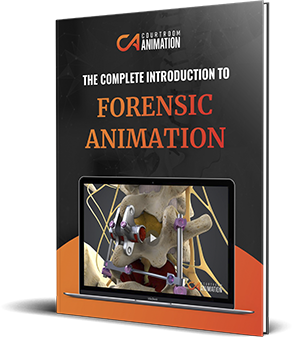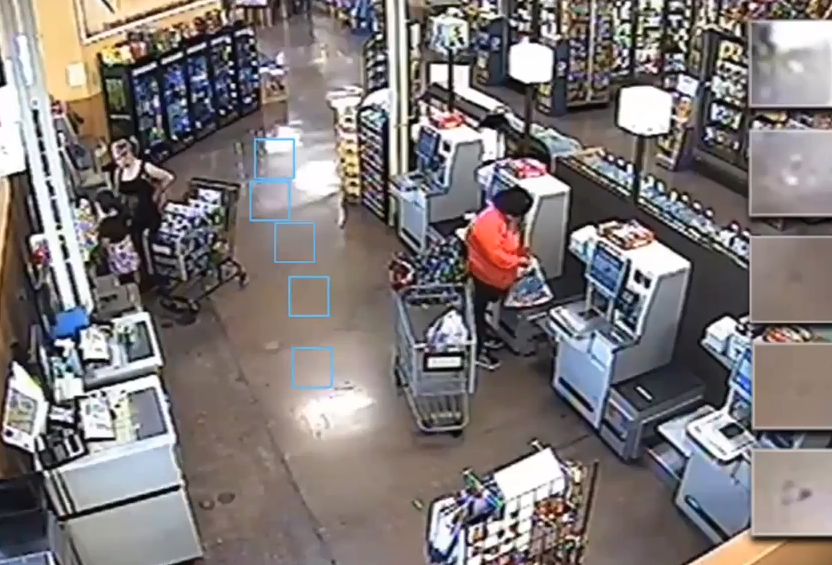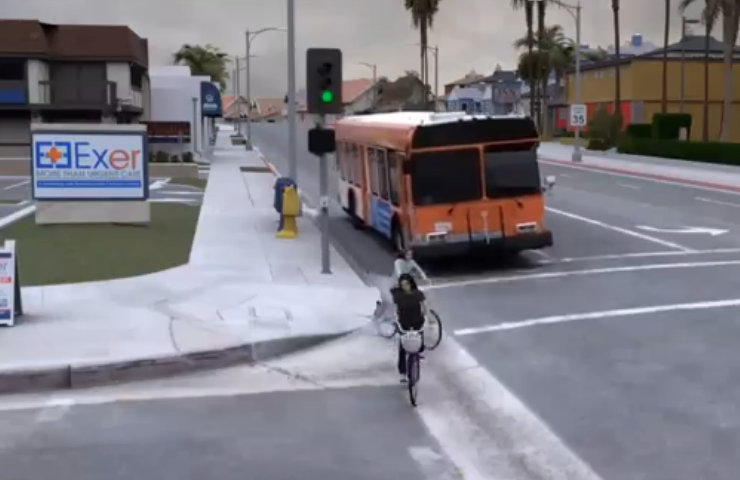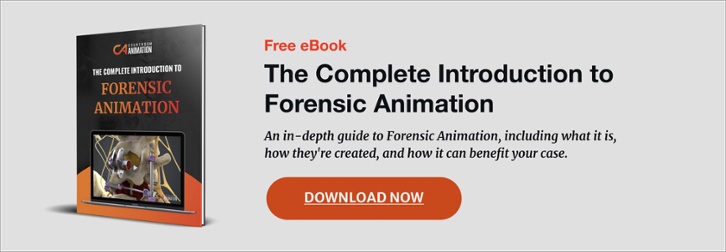What is Forensic Animation?
Forensic animation refers to the recreation of civil and criminal cases using modern computer graphics to help decision makers and stakeholders throughout the legal process.
The official definition is, “Forensic animation is a branch of forensic science in which audio-visual reconstructions of incidents or accidents are created to aid investigators.”
The use of forensic science in legal cases isn’t new by any means. Forensic science had been gaining traction all throughout the 1900s in Europe and the United States. Forensic animation is simply an evolution of the field.
What Does a Forensic Animator Do?
A forensic animator uses computer technology to recreate accidents or other incidents to support attorneys in receiving a favorable settlement or verdict.
In recent years, an animation can be much shorter, sometimes ranging from anywhere to 20 seconds to a few minutes. It’s a powerful tool for attorneys to help them reach a successful result for their clients. However, there are still many misconceptions about this kind of demonstrative evidence.
How Was the First Forensic Animation Video Created?
The first case that used computer animation was in the late 1980s, during the Connors v. United States case. This case revolved around the unfortunate crash of Delta Air Lines Flight 191. As part of the plaintiff attorney’s demonstration, they used a 45-minute computer generated presentation to explain the complex evidence.
Why Forensic Animation is Useful for Your Client’s Case
We’ve created this knowledge hub to answer any question you might have around how animation created, what tools are used in the process, and how it can help win your client’s case.
What’s the First Step in Creating a Legal Animation?
How Can a Trial Animation Win My Client’s Case?
Can Forensic Animation Convince a Jury?
Is 3D Animation Helpful for My Personal Injury Plaintiff?
What About My Defendant? Can They Use Legal Animation?
What Exhibit Works Best With a Legal Animation?
Can My Video Evidence Be Used in an Animation?
How Do Forensic Animation Companies Recreate My Video Evidence?
Are Car Crash Animations Helpful For My Case?

Free eBook: The Complete Introduction to Forensic Animation
For more information on Forensic Animation, download a copy of our free eBook. You will learn:
- What forensic animation is
- How they are created
- Which practice areas can benefit the most from legal animations
- How much a high-quality animation costs
- How to choose an animation provider
- If your case is a good candidate for animation
Legal animation is a necessary visual science.
Did you know that an average person’s attention span is about eight seconds?
This is why it’s crucial for a jury, and other legal parties, to quickly grasp your case’s facts in a courtroom. Using a visual is 650% better than using only an oral presentation, according to a Weiss-McGrath report. Forensic animation has been called the new modern technique in the litigation field.
The video above showcases just how varied our legal graphics can be. Our animations are so successful that they have a 99% admittance rate in more than 2,000 cases. The best way to use our animation services is for:
- Visually depicting crimes
- Simplifying a complex scientific process, like how a sinkhole develops
- Recreating accidents, such as a motor vehicle collision or pedestrian accident
- Showcasing a sequence of events
- Showing the moving parts of a piece of equipment or machinery
- Exploring alternative scenarios or angles
What’s the First Step in Creating a Legal Animation?
Forensic 3D animation is not a fabrication, it’s generated using real-world data and environments. The very first step in creating one is for a member of the animation team to travel to the site the incident took place. From there, they place an advanced 3D laser scanner on the ground. Once it’s turned on, it rapidly spins and captures data on the surrounding physical objects, trees, or buildings.
“Once the scanner starts working, it will project a laser line onto the object and then a sensor will measure the distance to the surface of the object. Once that data is processed it can be converted into a digital image and then a Computer-aided Design (CAD) model.”
A 3D laser scans collect hundreds of millions of data points that are accurate to the millimeter.
The above image is what a generic laser scan looks like. Larger objects are visible, such as trees, roads, and buildings, but the image is not clear. An animator can take these data points and use a computer program to generate 3D models.
These accurate 3D models are placed ‘on top’ of the scan, providing clearer physical properties. Here you can see the scene start to take shape with a solid environment. Every model and scan reflects the real world.
Textures, materials, colors, lighting, and other physical properties are then added. This is how 3D models are created before animation is added to the computer program.
How Can a Trial Animation Win My Client’s Case?
When preparing for your litigation case, you might wonder how an animation fits into the process. While 95% of cases end in a pre-trial settlement, a law animation can be helpful during mediation. Having a short but impactful trial animation from the start gives you an edge over the opposing party.
You can also:
- Invite the opposing counsel to comment.
- Show it to your expert during their deposition.
- Try to get the opposing expert to admit that it’s accurate.
- Put it on your exhibit list early, if your case goes to trial.

Forensic animation is best used to visualize powerful facts to help persuade your audience. An easy to follow visual also gives your expert an aid while explain their potentially technical subject.
Once someone understands the context and supporting evidence through your visual representation, they will have a better chance of retaining it during a later decision. The use of visual aids generally heightens retention of the spoken word – by 50% or more. This is supported by Edgar Dale’s theory, the Cone of Experience.
In short, using a visual can help increase the retention of your case’s facts, provide you with a compelling argument before mediation, and more.
Can Forensic Animation Convince a Jury?
Watch eight seconds of the video below to see for yourself the power of an animation. While this video was created for a motor vehicle collision case, it shows how quickly a jury can understand any incident we depict.
There are five key ways a forensic science animation can convince a jury. Overall, the main points come down to:
- Show events as they were seen, or could have been seen, from any party or witness’ perspective.
- Create accurate depictions of environments that changed since the event.
- Create an understanding of distances, sizes, and spatial relationships.
- Highlight key aspects of an event by speeding up or slowing down time in an answerable way.
- Depict complicated sequences as easy-to-understand, step-by-step actions.
This allows for a jury to see for themselves exactly how a situation played out. A lawyer can describe how fast two cars were going on a highway, what mechanical parts broke, or any injuries that occurred, but a thirty second video can make all the difference to a jury.
Humans are, for better or worse, visual creatures. An animation is the perfect way to convince a jury and achieve a favorable result for your client.
Is 3D Animation Helpful for My Personal Injury Plaintiff?
“This animation was pivotal in causing a zero-offer case to settle for $5.5 million in the afternoon of the first day of trial. I believe the animation caused the defense to develop more concern than we had!”
– Steve Vartazarian, The Vartazarian Law Firm
For plaintiff attorneys, 3D forensic animation can help in three main ways.
Clarify Your Expert Witness Testimony
This video can illustrate and reiterate the key details of the expert witness’s testimony. Not only does this make it easier for the jury to follow, but a well-organized animation can also help increase the emotional connection the jury has to your plaintiff’s plight.
HELPFUL TIP: During your expert’s deposition, show the animations while the opposing counsel is present. This allows the opposing attorney to cross-examine your expert on the foundation. This will go a long way in front of the judge and mitigate any argument of prejudice or surprise.
Settle Your Case Quickly & For More Money
Forensic animation can be used as leverage during mediation, direct settlement talks, and even mock settlement discussions.
Armed with a compelling animation, you may cause the defense to reevaluate the strength of their case, and in turn go back to their client and raise their settlement offer. In short, a persuasive visual may catch them off guard and help you reach a quicker settlement and for a higher value.
Increase the Chance the Jury Remembers Your Case
According to the book Perceptive Listening, people’s ability to accurately recall what was said to them is about 50% immediately following a presentation, and falls to about 25% after only one day.
These reasons and more are why forensic animation can be a valuable asset in any plaintiff attorney’s case.
What About My Defendant? Can They Use Legal Animation?
Don’t worry, trial animations are also useful to those representing the defense. Animations show no bias as they are data visualizations that refine the data from your case to a realistic and objective recreation.
Whether it’s personal injury, patent infringement, premises liability, product liability, construction, third party liability or any other area of the law, an animation can support your case.
Did you know an American survey showed that members of a jury will retain twice the amount of information when using a visual presentation?
Would a Forensic Animation Work For Insurance Companies & Policyholders?
Yes! When it comes to insurance companies in particular, the cost of damages and settlements that result from claims or suits covered by policies can be exorbitant.
By investing in 3D forensic animation, liability insurers can minimize risk and limit damage. An animation accomplishes this by:
- Proving negligence: Demonstrate how the actions of the plaintiff caused or contributed to his or her own plight.
- Emphasizing the facts: Present facts in a cohesive narrative while staying distant from any emotions or shock reactions.
- Creating a lasting impression: Mediators and jurors will remember the exhibit that pieced the entire case together.
According to the authors of Forensic Technologies in the Courtroom: A Multi-Disciplinary Analysis, “Strong support suggests that forensic animation is the first paradigm-shifting courtroom technology since the acceptance of photography.”
If you’re evaluating a case for 3D Forensic Animation, download our free checklist to see what is involved in preparing your case:
Free Checklist: How to Prepare Your Case for Working with a Forensic Animation Studio
Prepare your case for working with an animation studio using this short step-by-step checklist.
What Exhibit Works Best with a Legal Animation?
There are three types of trial exhibits that you can’t have without animation. The first type of legal exhibit is the “Could Have, Should Have, Would Have” analysis. For example, these 3D ‘shorts’ can answer questions like:
What would have happened to your client if that department store had installed the handrail to code?
What would have happened had the plaintiff been traveling at the speed limit instead of 15 MPH faster?
The animation sample below shows how our animators manipulated a past situation by showing what could have happened, what should have happened, and what did happen.
Basically, our team was tasked with analyzing two surveillance cameras that caught different portions of the event. We were able to depict the motorcycle at different speeds versus the box truck’s complicated maneuver. We show exactly what would have happened had the plaintiff applied proper braking pressure along a proper path as opposed to trying to swerve around the truck.
What if the incident’s environment has changed?
It is not uncommon for investigations of cases to happen weeks, months, or even years after the fact. During this time the environment can change in a multitude of ways.
This is where our time machine exhibit example comes into play.
For instance, trees that may have previously blocked the field of view could have been removed, a crosswalk was installed, or time ran its course and degraded a previously safe area.
What about different perspectives?
This is where our forensic animators perform a site inspection. We physically visit where an incident took place, and collect important data to help us create effective trial graphics from a first-hand perspective. We use tools like the 3D laser scanners to ensure that our content is scientifically accurate.
An animation can show this type of exhibit as well. The final kind of exhibit that we suggest using animation for is to give the judge and jury the ability to “be in the driver’s seat.”
It does not matter whether you are a plaintiff or defense attorney, it’s safe to assume that you have had to argue your client’s ability to see or not see an avoidable or unavoidable situation. This allows us to show how some situations were completely unavoidable.
We have created animations from multiple perspectives to realistically and accurately depict a motor vehicle collision, and other types of accident reconstruction.
This is why legal teams from all over are tapping into animation services to supplement their verbal argument with a powerful visual exhibit.
Can My Video Evidence Be Used in an Animation?
The use of digital evidence has increased in the past few decades, so it’s important to stay up to date on the latest legal technology methods. If your video evidence originates from:
- Security cameras
- Traffic and toll-booth cameras, including red-light cameras
- Law enforcement cameras
- Phone recordings
- Or others
Then a team of animators can use it to slow down time, change perspectives, or analyze the scene. So how can forensic computer animation from video evidence help your case?
Is Video Enhancement an Option for a Court Animation?
Of course, you can’t create something from nothing if the detail isn’t there. You can’t make a video higher resolution, but our animators can reveal what is already there and show it in a more digestible way. Take a look at this image from a store camera:

The image in this video shows the scene right before a woman slips and falls in a grocery store. Prior to this point in the video, an employee is walking with a soda in her hand. When we enhanced the video on areas of the floor before and after the employee walks by, the spots appear.
Can You Recreate a Video?
Unfortunately, the perfect video rarely exists that shows the perfect angles of how an incident took place. In these situations, video recreation is the next best thing. It allows us to re-contextualize the scene from a new perspective in a forensic computer animation.

The video that our team had to work with was from a surveillance camera across the street on the right side of this image. By recreating the scene with forensic computer animation, we’re able to show what happened from several different angles.
Is it possible for my video recreation to be shown in a different perspective?
With video evidence, there are often elements that are hard for jurors to watch or have emotional components that can cloud their judgment. As forensic computer animators, we want to take out any feelings so that viewers only see the facts. Forensic animation allows us to reduce implicit biases, such as around race or even with gruesome elements.
Overall, forensic computer animation can help your case by:
- Analyzing the incident so relevant parties can understand spacing, timing, etc.
- Enhancing key points in a video to point out any missing information.
- Recreating a video from a different angle to provide a new perspective.
- Using different perspectives to remove potential bias.
How Do Forensic Animation Companies Recreate My Video Evidence?
One of the key capabilities of forensic animation companies like Courtroom Animation involves taking video evidence and turning it into an engaging 3D animation. A limitation of video is that it’s essentially a series of pictures in a flat, 2D type of media. Forensic animation companies can recreate video evidence and increase their impact by showcasing them in a 3D format. This allows viewers to see relationships between objects, timing, different perspectives, and other real-world aspects.
How do they actually build the forensic computer animations?
Forensic animation companies will typically start with a laser scan of the area where the incident took place. From those accurate data points, animators can build 3D models. They can add vehicles, textures, material properties, and lighting to the digital environment.

Video evidence doesn’t just have to come from surveillance video. Smartphone and bodycam footage is often available to be used as evidence, so there are often multiple recordings from the incident. This allows forensic animation companies to analyze different positions of people and distance relationships using photogrammetry.
Don’t forget that forensic animations also work well in mediation!
Use this free checklist before you meet with an animator to be prepared and know what key parts of your case you want to highlight.
Are Car Crash Animations Helpful For My Case?
Since motor vehicle accidents might be hard to explain verbally to an audience, a car crash animation can help win your court case by showing a powerful visual of the incident. With these types of supporting legal graphics, you can increase the chances a jury remembers your key facts by:
Slowing Down Time
As cars sometimes drive too fast to track visually, a car crash animation can be helpful for a jury or other courtroom parties. It can show how little time someone had to react to a situation, or allow audiences to observe otherwise difficult-to-see events.
Show Driver Behavior
Car crash animation is a great way to showcase the way people or vehicles behaved before, during, and after a collision took place. Without forensic animation, it’s extremely difficult for relevant audiences or a jury to understand behaviors based on eyewitness testimony and verbal presentations, whether they are plaintiff or defense cases.
Visualizing Different “What If” Scenarios
At Courtroom Animation, we use “ghosted animation” to depict these alternative scenarios. For instance, we can show how an event unfolded, such as a car or person running through an intersection. And then we can show a “ghost” motor vehicle in the collision, which represents the alternative scenario, which shows what would have happened if the car had stopped before the intersection.
Alternative scenarios show the jury what could have happened or what should have been avoided.
Use Legal Technology to Leave an Impression
One of the powerful aspects of car crash animation is how realistically events are portrayed. Especially compared to computer-generated simulations, it leaves a better and longer-lasting impression on jurors and other viewers.
Compared to seeing all the factors of a car crash collision separately, a 3D animation ties together injuries, damages, and more into one legal graphic. This way, a jury and others will better remember what happened so they can make better informed decisions.
Can Injury Animation Be Useful For My Personal Injury Client?
For attorneys trying to achieve successful personal injury settlements, injury animation is fast becoming their top supporting tool. We can use 3D forensic animations to better visualize surveillance footage, recreate scenes based on witness accounts, recreate surgical operations based on facts, and more.
“I analyze everything that I can because words aren’t enough,” said Steve Vartazarian. “The jury expects you to use technology. You should, why wouldn’t you if it’s available?”
Steve Vartazarian at The Vartazarian Law Firm
What About Injury Animation Admissibility?
If you’ve confirmed your animation with all the experts, used data points, involved the eyewitness accounts, taken a laser scan of the scene, then there is little reason a judge would not permit you to show your animation to a jury.
To be admissible in court, an animation must meet specific requirements and be based on established facts. While there is no guarantee that an animation will be admissible, trial judges will review them before the trial and express any objection.
Are Injury Animations Evidence?
The short answer is no. Animations are not created to become new evidence, their sole purpose is to help give authority to your case and convince your audience.
I’ve Never Used Forensic Animation, is it Really Worth it?
Not all lawyers use animation for their clients, but you should be aware of the benefits and how they are created in case the opposition brings one to court.
In fact, you might recognize one animation that went viral and displayed the power of our forensic animation services. This major media was the video from the Caitlyn Jenner car crash case when she rear-ended two cars in Malibu.
An important takeaway from the Caitlyn Jenner car crash animation going viral is that the majority of people who viewed it were regular, everyday people. The millions of views did not come from legal experts, attorneys, forensic experts or people who are involved with the legal industry.
The animation was sought out by people who wanted to know what really happened – laypeople, or potential jurors.
Forensic animation services in litigation play a very important role because it has a very strong effect on people, and it resonates more strongly with the audience than complex verbal testimony. There is no doubt that legal animation is a powerful tool, and is quickly becoming more mainstream and in demand in courtrooms across the country.
We hope this guide has answered every question you might have about forensic animation. If you have more questions or want to see if your case can use an animation or graphic, check out our other blogs.
